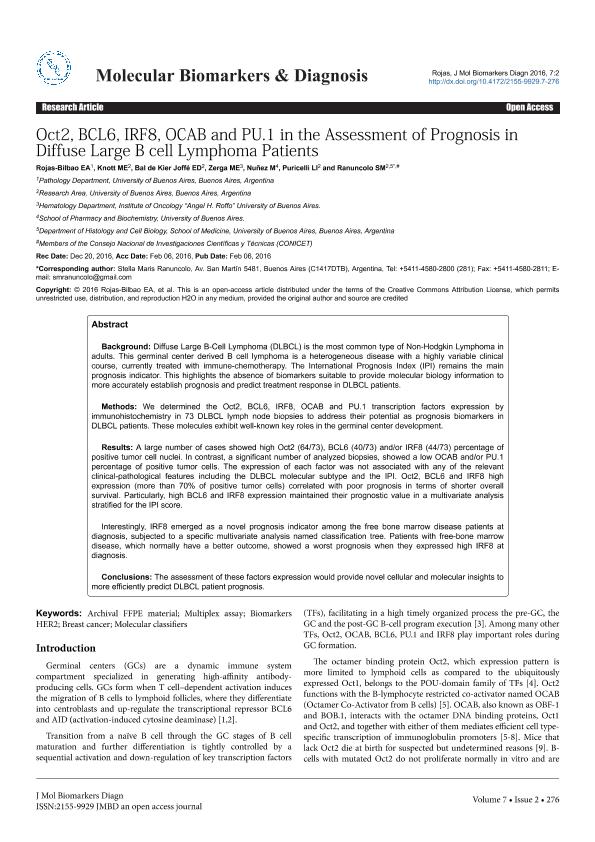Artículo
Oct2, BCL6, IRF8, OCAB and PU.1 in the Assessment of Prognosis in Diffuse Large B cell Lymphoma Patients
Rojas Bilbao, Érica; Knott, María Elena ; Bal, Elisa Dora
; Bal, Elisa Dora ; Zerga, M. E.; Nuñez, M.; Puricelli, Lydia Ines
; Zerga, M. E.; Nuñez, M.; Puricelli, Lydia Ines ; Ranuncolo, Stella Maris
; Ranuncolo, Stella Maris
 ; Bal, Elisa Dora
; Bal, Elisa Dora ; Zerga, M. E.; Nuñez, M.; Puricelli, Lydia Ines
; Zerga, M. E.; Nuñez, M.; Puricelli, Lydia Ines ; Ranuncolo, Stella Maris
; Ranuncolo, Stella Maris
Fecha de publicación:
02/2016
Editorial:
OMICS International
Revista:
Journal of Molecular Biomarkers and Diagnosis
ISSN:
2155-9929
Idioma:
Inglés
Tipo de recurso:
Artículo publicado
Clasificación temática:
Resumen
Background: Diffuse Large B-Cell Lymphoma (DLBCL) is the most common type of Non-Hodgkin Lymphoma inadults. This germinal center derived B cell lymphoma is a heterogeneous disease with a highly variable clinicalcourse, currently treated with immune-chemotherapy. The International Prognosis Index (IPI) remains the mainprognosis indicator. This highlights the absence of biomarkers suitable to provide molecular biology information tomore accurately establish prognosis and predict treatment response in DLBCL patients.Methods: We determined the Oct2, BCL6, IRF8, OCAB and PU.1 transcription factors expression byimmunohistochemistry in 73 DLBCL lymph node biopsies to address their potential as prognosis biomarkers inDLBCL patients. These molecules exhibit well-known key roles in the germinal center development.Results: A large number of cases showed high Oct2 (64/73), BCL6 (40/73) and/or IRF8 (44/73) percentage ofpositive tumor cell nuclei. In contrast, a significant number of analyzed biopsies, showed a low OCAB and/or PU.1percentage of positive tumor cells. The expression of each factor was not associated with any of the relevantclinical-pathological features including the DLBCL molecular subtype and the IPI. Oct2, BCL6 and IRF8 highexpression (more than 70% of positive tumor cells) correlated with poor prognosis in terms of shorter overallsurvival. Particularly, high BCL6 and IRF8 expression maintained their prognostic value in a multivariate analysisstratified for the IPI score.Interestingly, IRF8 emerged as a novel prognosis indicator among the free bone marrow disease patients atdiagnosis, subjected to a specific multivariate analysis named classification tree. Patients with free-bone marrowdisease, which normally have a better outcome, showed a worse prognosis when they expressed high IRF8 atdiagnosis.Conclusions: The assessment of these factors expression would provide novel cellular and molecular insights tomore efficiently predict DLBCL patient prognosis.
Palabras clave:
Dlbcl
,
Prognosis_Biomarker
,
Germinal_Center
,
Oct2
,
Bcl6
,
Irf8
,
Ocab
,
Pu.1
Archivos asociados
Licencia
Identificadores
Colecciones
Articulos(OCA HOUSSAY)
Articulos de OFICINA DE COORDINACION ADMINISTRATIVA HOUSSAY
Articulos de OFICINA DE COORDINACION ADMINISTRATIVA HOUSSAY
Citación
Rojas Bilbao, Érica; Knott, María Elena; Bal, Elisa Dora; Zerga, M. E.; Nuñez, M.; et al.; Oct2, BCL6, IRF8, OCAB and PU.1 in the Assessment of Prognosis in Diffuse Large B cell Lymphoma Patients; OMICS International; Journal of Molecular Biomarkers and Diagnosis; 7; 276; 2-2016; 1-9
Compartir
Altmétricas



